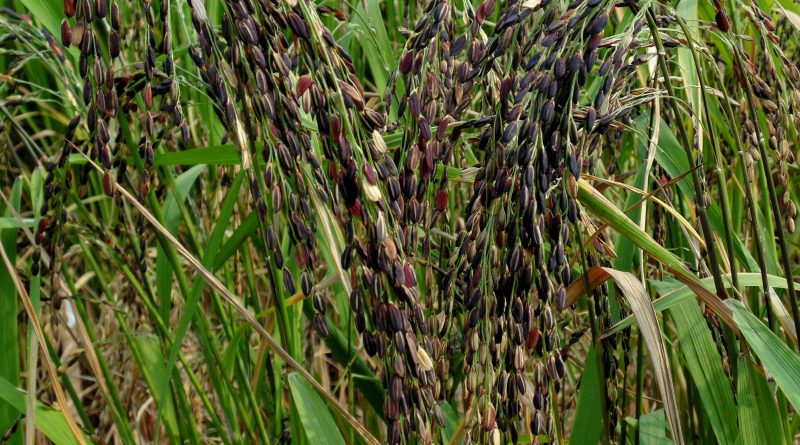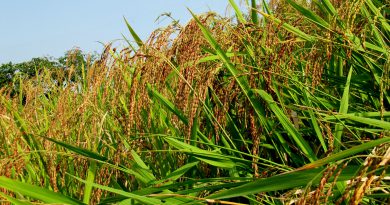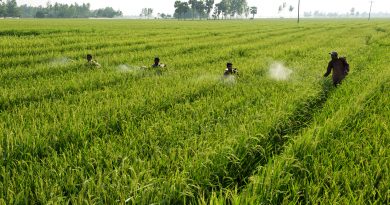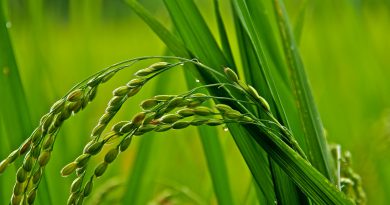Diversity of granule-bond starch synthesis (GBSS) levels in North Vietnam local rice cultivars
HOAI. T. T., A. NISHI and H. SATOH
In Rice Genetics Newsletter Vol. 24 (pages: 62-64), A Publication of Rice Genetics Cooperative Genentic Resources Section National Institute of Genetics Mishima, Japan; Kyushu University, Faculty of Agriculture, Hakozaki, Fukuoka, 812-8581 Japan.
Amylose, which makes up 20 to 30% of rice starch, is an important factor affecting the cooking and eating quality of rice. The synthesis of amylose is catalyzed by the granule-bound starch synthases (GBSS) encoded by Wx gene. In order to provide useful information to rice quality breeding program, this study deals with the diversity of GBSS level and apparent amylose content in Northern Vietnam local rice cultivars.
185 local rice cultivars collected from mountainous areas of Northern Vietnam, were used in this study. Three varieties including Kinmaze, IR36 and EM 21, (a waxy mutant form Kinmaze) were used as controls. Expression levels of GBSSwas determined by SDS-PAGE and western blotting analyses. The apparent amylose content in the endosperm starch was estimated by the iodine-starch colometric method.
Variations in GBSS levels were observed among 185 samples (Fig. 1A). Kinmaze and IR36 were distinguished from each other by the staining intensity of 60kDa bands. High intensity of GBSS (Wxa) was found in IR36 while low intensity of GBSS (Wxb) was found in Kinmaze. GBSS was absent in EM21 (wx). Based on the iodine staining intensity, 185 rice cultivars were classified into four groups; absent (EM21 type), low (Kinmaze type), intermediate (intermediate between Kinmaze and IR36) and high GBSS (IR36 type), having frequencies of 52%, 12%, 9% and 26%, respectively. The apparent amylose content in Vietnam cultivars varied from 0 to 32% and they were grouped into waxy (0-2%), very low (3-6%), low (9-12%), intermediate (13-18%), high (19-24%) and very high (≥25%) (Table 1). More than 50% of total cultivars belong to waxy a group. In non-waxy groups, a wide variation in apparent amylose content was observed. Fig. 1B shows the correlation between the GBSS level and the apparent amylose content. In waxy rice groups, despite the absence of GBSS, a variation in iodine staining intensity was observed. Some previous studies reported that the colometric method of estimating apparent amylose content is affected by amylopectin structure (Nishi et al. 2001) with some rice amylopectin having longer chains able to bind iodine (Takeda et al. 1987). Thus, the variation in iodine staining intensity among waxy rice cultivars could be caused by the presence of variable amounts of amylopectins. A continuous variation of apparent amylose content was observed in cultivars having different GBSS levels. For non-waxy rice, GBSS low-level cultivars had apparent amylose content varied from 9% to 24%, while intermediate and high GBSS cultivars showed apparent amylose content varying from 9 to 28% and 16 to 32%, respectively. This continuous variation in the apparent amylose content may be caused by some combinations of the variation of GBSS levels and the amount or structure of amylopectin. Local rice germplasms from Northern Vietnam exhibited a high diversity both in GBSS level and apparent amylose content.
Research Notes 63
References
Nishi A., Y. Nakamura, N. Takana and H. Satoh, 2001. Biochemical and genetic analysis of the effects of amylose-extender mutation in rice endosperm. Plant Physiol. 127:459-472.
Takeda Y., S. Hizukuri and B. O. Juliano, 1987. Structure of rice amylopectin wih low and high affinities for iodine. Carbohydrate Research 168: 79-88.



